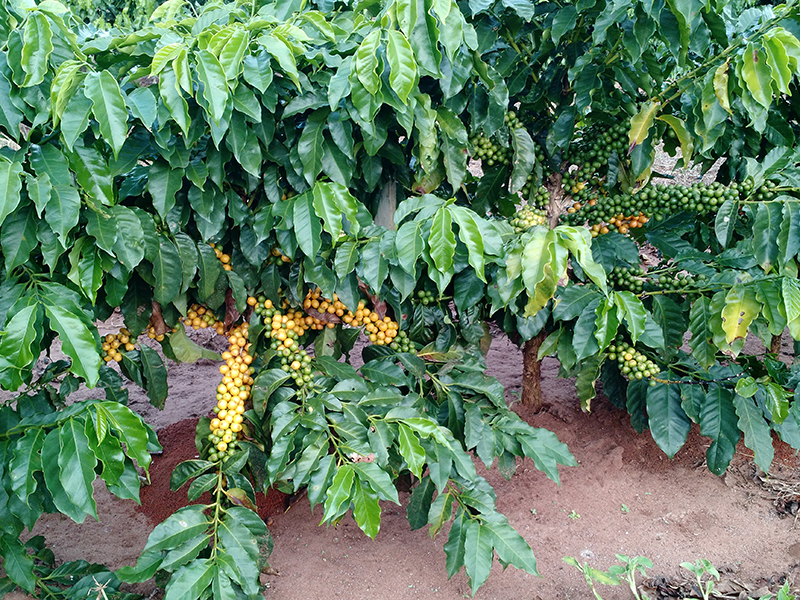
The immediate take home and this surely applies to almost all crops, is that a measure application of good old limestone is ideal in order to eliminate soil acidity which can arise for all sorts of reasons, not least excess fertilizers.
This will become an easy standard to impliment. Obviously these growers addressed here have not been doing this.
Limestone is likely the easiest mineral for soil beneficiation. Most places it is often possible to crush your own.
Limestone improves coffee yield and profitability
Your morning cup o' Joe depends on healthy soil
August 11, 2021 - The perfect cup of morning coffee. Before you even purchase the beans at the store, many things must go right before that great-tasting coffee can be poured into your favorite mug. It starts in the soil where farmers grow the beans. For example, Brazil is the world’s biggest coffee producer, and the soils there can cause problems for coffee plants.
The tropical soils coffee calls home are naturally acidic and low in the minerals calcium and magnesium. In addition, adding fertilizer to the soil adds to its acidity. This all adds up to lower yields for coffee plants.
Rogério P. Soratto is a researcher in Brazil who studies if limestone and phosphogypsum could help improve the soil. Soratto and colleagues recently published their research in Agronomy Journal, a publication of the American Society of Agronomy.
“Soil acidity and low concentrations of exchangeable calcium and magnesium are among the main factors that limit coffee yield,” Soratto explains. “So we did a field experiment to test the effect of band application of limestone and phosphogypsum. We studied them alone and combined to see their effects on plant nutrition, yield, and profit.”
In the study, researchers used different amounts and combinations of just limestone, just phosphogypsum, and the two combined. Each impacted the soil chemistry in a different way. They applied the treatments at the base of the coffee plants, as a band under the plant canopy.
Limestone is a source of calcium and magnesium. Its action can often be limited to the soil surface where it is applied. Phosphogypsum contains calcium and sulfur. It is better able to take calcium deep into the soil. However, the researchers found it wasn’t so easy to simply combine the two treatments.
“In our study, the combined application of limestone and phosphogypsum greatly increased the calcium concentration in the soil and also caused an unbalance of the soil chemistry, overall,” Soratto says. “This may have lowered potassium uptake by the coffee plants at the phase of greatest demand, which is the fruit-filling stage.”
Ultimately their study found that applying only limestone was the most effective treatment. If the acidity of the subsoil is an issue, they recommend low phosphogypsum rates. This will avoid throwing off the soil chemistry.
When applied to the soil, limestone makes it less acidic and supplies calcium and magnesium. It also lowers toxic aluminum and manganese in the soil. This helps increase the activity of helpful soil microbes. Lastly, it makes fertilizer more effective. This allows crops to perform better and be more economically viable.
“In southeastern Brazil, the climate is favorable for the good growth of Arabica coffee trees,” he says. “It can allow producers to harvest fruits with a good drinking quality. However, this is only possible in well-managed crops because in this region, most soils are acidic.”
Most importantly, the limestone application that performed the best increased both coffee yields and economic returns by more than 40%.
“This research is important because coffee is widely cultivated around the world and soil acidity problems often limit the bean yield of coffee plantations,” Soratto says. “As we have shown in our research, fixing soil acidity and providing calcium and magnesium is critical. However, the application of too much calcium using limestone and phosphogypsum at high rates becomes harmful.”
It is not well known that applying limestone and phosphogypsum together is not always the best option. Their future work hopes to investigate this further and educate coffee farmers.
“Limestone and phosphogypsum applications are extremely important soil amendment practices for coffee production, not only in Brazil, but also in other producing countries,” Soratto says. “To obtain high coffee yields, we must first improve the root environment, helping the plants better exploit the soil resources.”
Rogério P. Soratto is a professor at São Paulo State University (UNESP). This research was funded by the Brazilian National Council for Scientific and Technological Development (CNPq).
Photo Caption: The type of coffee grown for this experiment has yellow berries that mature in April and May. Credit: Renan J. Parecido
For more high res photos, please contact Susan Fisk, sfisk@sciencesocieties.org.
American Society of Agronomy, Soil Science Society of America, Crop Science Society of America: Collectively, these Societies represent more than 12,000 individual members around the world. Members are researchers and professionals in the areas of growing our world’s food supply while protecting our environment. Together we work toward solutions to advance scientific knowledge in the areas of agronomy, crop science, and soil science.
No comments:
Post a Comment